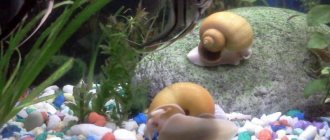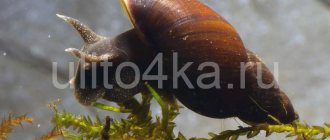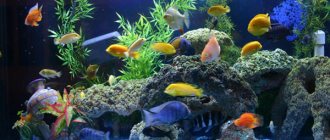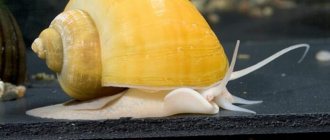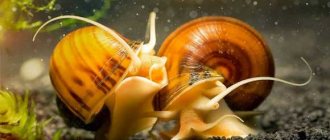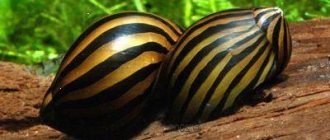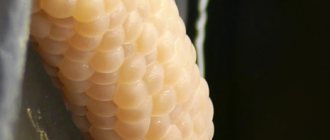An aquarium in which only fish swim looks dull. It doesn’t look like a real underwater world, where all kinds of mollusks should live, so people also get snails. When used in moderation, they perform not only an aesthetic, but also a practical function. Snails collect food not eaten by fish, excrement, purify water, and remove plaque from the walls. By their behavior you can easily understand whether there is enough oxygen in the water. If not, then the mollusks rise to the surface. Let's look at the types of aquarium snails and the main rules for keeping them.
Ampularia
This type is considered the most common. Beginning aquarists, going to specialized stores, usually choose just such snails, since they are not uncommon on sale, are easy to care for, and are inexpensive. You can keep ampularia in any aquarium and with different types of fish, since they do not harm anyone, but they themselves often become victims.
Some fish willingly pinch their antennae, as they prefer mollusks in the form of live food. Therefore, before purchasing, consult with sellers about the compatibility of ampularia and the population of your aquarium. For example, these snails will not get along with cichlids, gouramis, and tetradons.
Snail care
In order to understand how to properly care for shellfish at home, it is important to follow the following rules:
- clean the terrarium at least 3 times a month;
- the substrate is changed every six months;
- add additional calcium to your diet. This will further strengthen the shell;
- Avoid frequent contact of gastropods with humans.
Snails cleaning the walls of the aquarium can accumulate in one place. Therefore, it is necessary to monitor and distribute gastropods throughout the container.
Marisa
Wherever representatives of this species live: in rivers, stakes, lakes, swamps, but the main condition for them is rich vegetation. These snails are quite large: the shell width is about two centimeters and the height is five centimeters. There are yellow stripes on the shell.
Marises are unpretentious in terms of keeping conditions. The water must maintain an alkaline balance of pH 7-8, and the optimal temperature in the aquarium is 25 degrees. If the water is too soft and completely devoid of acidity, then the shell of these snails begins to collapse. It is not advisable to combine mariz with predatory and aggressive fish. If you have such a pet, then do not forget that it needs excellent water filtration. From high concentrations of nitrogen, snails get sick or even die.
Coil snails as cleaners in an aquarium
Coils, of course, eat lower algae, which are present in varying quantities in any aquarium. However, they do this in a very specific way. For example, if the walls of the aquarium are overgrown with green algae. the coil never cleans them off in even sections, but eats them as it moves. Leaving behind curved paths cleared of algae. If there are a lot of snails, then the entire glass of the aquarium acquires an ornate pattern over time. The same thing applies to plants on which algae have settled. On them, the coils will also leave tracks cleared of algae and areas with uncleared algae.
In other words. Clean then they clean. But all the same, the aquarist will have to take up the scraper and clean off the fouling himself. Coil snails should rather be considered as aquarium orderlies. As stated above. They are excellent at eating food that has not been eaten by fish and the remains of rotting plants; they cope with this task with a bang.
Here is a short video that I specially made. So that you can see how the coil snails unevenly clean off fouling from the glass of the aquarium.
Melania
In the reservoirs of our country, it is impossible to meet a mollusk with a name consonant with a woman’s name, since they live exclusively in Asia, Australia and Africa. Melania snails choose soil for themselves, where they feed, hide from predators and give birth. Aquarists often bring these pets from pet stores without knowing it, since they are found along with the water in which the fish are sold. For this reason, the mollusk received the offensive status of a parasite. In fact, like its other relatives, it is beneficial, but it multiplies too quickly, which is why getting rid of it is not an easy task.
Aquarium snails: balance and population
Even the most experienced and careful aquarists often face the problem of the unplanned appearance of snails or their sharply increased number. To benefit from their presence, it is necessary to control the population.
You can do this as follows:
- Disinfect new plants with solutions of potassium permanganate or saline solution;
- Use special chemicals from a pet store (a more radical method);
- Place in the aquarium fish that eat snails, for example, dwarf tetradons;
Dwarf tetradon feasts on a snail - Reduce the amount of feed. The appearance of snails may indicate overfeeding of the fish;
- Manual extraction will allow you to get rid of large specimens;
- Place a scalded lettuce or zucchini leaf in the aquarium overnight. Since snails eat vegetables with great pleasure, they will concentrate on their favorite treat and you can safely remove them in the morning.
Such simple methods will allow you, if not to completely get rid of unwanted “guests,” then to significantly reduce their number and ensure the care of the aquarium.
Corbicula
The snail received two more names: “bivalve”, “Javanese ball”. It is most widespread in the nature of Southeast Asia. Corbicula lives in fresh water bodies in different parts of Indonesia, Vietnam and China. It is also found in Japan, although its “close relative”, Corbicula japonica, is popular there. These snails grow up to three centimeters in diameter and live for seven years.
The species belongs to the category of benthic mollusks, as it likes to burrow into the ground. Snails feed on organic particles, filtering them from the water. Corbicula requires special attention. So, the water temperature should fluctuate between 22-27 degrees; deviation from this norm can lead to the death of the snail. The mollusk is not able to survive in conditions of increased nitrogen compounds and lack of oxygen.
Neretina
To prevent such an underwater inhabitant from getting a disease in the form of shell erosion, monitor the water parameters. Increased acidity has a detrimental effect on the health of neretins. Aquarists advise maintaining a harsh alkaline environment. The water temperature for keeping such snails should be from 22 to 26 degrees, and the volume of the aquarium should not be less than eight liters per such mollusk. Experts say that the larger the volume, the more comfortable it is for non-retina.
To avoid exposing your pets to various risks, avoid changes in water levels. Install powerful filters, and change about 30 percent of the water in the aquarium every week. Do not keep such snails in an aquarium without a lid, as they will not miss the right moment to escape and go for a walk throughout the apartment.
Advantages
In small quantities, snails can be useful for the aquarist. Many of them feed on carrion, eat algae and detritus, which help to some extent clean the aquarium (you should not try to delegate all the work of maintaining the aquarium to snails - this is still your task), and some species, for example, the Malaysian sand melania, due to their habit dig into the ground in search of food, turn over the soil granules, which prevents it from caking and the formation of hydrogen sulfate, which is toxic to fish in large quantities.
Sometimes aquarists specifically add certain types of snails to the aquarium, either for the reason mentioned above, or simply because snails can also be an interesting and colorful addition and decoration to the aquarium.
Pokemon
Pokemon come from the tropics, so they are also called tropical pond snails, which are analogues of our pond snails. Most often, Pokemon are found in swamps and shallow bodies of water in Indonesia and Malaysia. They do not live long in aquariums - only a year. During their short life, these snails eat a huge amount of algae, including blue-green algae. Their diet consists mainly of deteriorated leaves. Pokemon scrape the walls of aquariums very well, which is why breeders love them. Such snails do not show any aggression towards the population. The optimal water temperature for keeping these snails is 22-28 degrees.
Plants for a terrarium with snails
Although snails are omnivores and can eat a variety of plants, there must be some fauna present in the pond. Ivy, ferns, and various types of aquatic mosses are perfect for an aquarium with mollusks.
Before “planting” plants into a pond, it is necessary to keep them in warm salt water. This way you can get rid of possible infections. After ten minutes, the plants should be rinsed thoroughly. Freed from harmful parasites and other uninvited guests, the aquarium can be enriched with green spaces.
Pagoda
It is impossible to confuse this snail with any other, since the shell of this species looks like a pagoda, hence the name. A pagoda, let us remind you, is a tower with a multi-level structure. This mollusk was first described by British naturalist John Gould. This was in 1847.
These snails are distinguished by their calm disposition, thanks to which they get along with all the inhabitants of the aquarium, however, they take a long time to get used to the new environment, and can not get out of their hiding place for a whole day. They feed on algae and growths, thereby keeping the aquarium clean.
Spixie
This species belongs to the ampullaria family, but differs from its usual representatives in its long antennae, speed and habits. They lay their eggs under water, in the ground, and ordinary ampularia - on the water surface.
Spixies are found in various bodies of water in South America. The shape of these snails is oval, the slightly narrowed shell is colored in a light shade with stripes. The spixie has a spotted body, darker than the shell, in some cases acquiring a brown tint. These mollusks are small in size; males reach a diameter of only two centimeters, and females - three. Spixies live for a relatively long time - five years.
Snails to Avoid
Different types of mollusks can be found in an aquarium, and most are practically harmless in small quantities. For a snail, an aquarium is just a home, but at the same time, with its presence, it plays the role of a nurse and maintains a favorable environmental situation in the home.
But there are also parasitic snails that can spread infections and be carriers of worms. And some species even eat algae and other plants.
You should be wary and wary of introducing snails caught from a pond or river into an aquarium.
Individuals to avoid include:
- lawn;
- pond snail;
- pearl barley
Melania is also considered a controversial species. She constantly swarms in the soil, stirring it up, preventing it from souring. Thanks to this, the bottom constantly moves, improving air exchange. But melania tends to multiply quickly and it is difficult to control this process. And it's difficult to get rid of it.
Most often in the aquariums of compatriots you can find melania, phys, coils, and also ampullaria. The latter do not start on their own - such snails are purchased at a pet store.
Dreissena river
These bivalves have gained wide popularity among aquarists. In nature, they live not only in fresh, but also in brackish water bodies. Their shell is greenish-yellow and shaped like a triangle. Zigzag stripes of brown color run across the shell. Adult mollusks reach a length of five centimeters. They feed by passing water through their gills. They breathe in the same way.
Small aquariums are not suitable for keeping zebra mussels. The minimum container size should be 90 liters. The recommended water temperature is 18-27 degrees. There are no other care requirements.
River viviparus (Viviparus contectus)
Habitat. The homeland of the river viviparus is Europe. The mollusk lives in ponds, lakes, and any bodies of water with standing water and dense vegetation. The livebearer prefers to stay on plants or in silty areas of the reservoir.
Appearance and color. The shell of the Livebearer is round with a cone-shaped top, about 5 cm long and has 6-7 curls of brown-green color with black stripes. The Livebearer, like the Ampularia, has a lid that it closes in case of danger. The mollusk breathes using gills. In nature, you can also find other species of Livebearer: Amur, Bolotnaya, Ussuri, and Minted. All these species differ mainly in the structure and color of the shell.
Sexual characteristics. Livebearers are dioecious. Males differ from females in their head tentacles: in females these tentacles are of the same thickness, in males the right one is greatly expanded and plays the role of a copulatory organ (Zhadin, 1952).
Maintenance and feeding. Probably the most unpretentious snail to keep. Any volume is suitable, even a 3-liter jar, the main thing is that there is enough food for the snail. There are also no special requirements for water, because in nature the water in ponds is far from clean, but as a rule, snails are kept in common aquariums and the conditions created there will be ideal for Livebearers. Like all snails, the Viviparus is an aquarium orderly, eating leftover food, detritus, dead fish,
aquarium plants . Like all aquarium inhabitants, snails need to be monitored; if you see that a snail has been lying in one place for several days, then it needs to be taken out and examined; dead Livebearers, like other snails, heavily pollute the water, such snails need to be removed from the aquarium. Since the mollusk spends most of its time at the bottom, it can be fed with catfish food. As aquarists say, for a 50-liter aquarium, 10 livebearers are enough.
Breeding and reproduction. To breed Livebearers, you will need several individuals (2-4 pieces) or more. Females can bring about 30 snails of their own kind. Young snails are born with a transparent shell and protective shell, which is required for snail adaptation. The birth is somewhat reminiscent of the birth of viviparous fish. After a short time, the young snail turns the same color as its parents.
Behavior in the aquarium. Peaceful aquarium inhabitants, they can live together with other species of snails such as Melania, Physa, etc.
